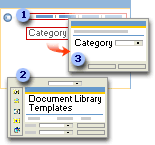
A document library provides a structure for storing files in your web site that is easy for you to set up and maintain, and is easy for site visitors to use. You can create separate document libraries for different kinds of files. For example, you might create one document library for expense reports and another for memos.
Important To create a document library, your web site must be on a server that is running SharePoint Team Services from Microsoft.

![]() Document libraries provide a built-in structure and commands for adding documents.
Document libraries provide a built-in structure and commands for adding documents.
![]() Templates provide a seamless experience for users of a SharePoint Team Services-compatible client program, such as Microsoft Office XP.
Templates provide a seamless experience for users of a SharePoint Team Services-compatible client program, such as Microsoft Office XP.
![]() Users fill in custom properties when they save a document.
Users fill in custom properties when they save a document.
![]() Built-in structure
Built-in structure
By using document libraries, site visitors can contribute content to the appropriate page on your web site even if they know nothing about the structure of your web site. Hyperlinks to documents are kept up to date automatically, and a view of the library is automatically displayed on a page on your web site.
When you create a document library, a document library folder ![]() is added to the folder list of your web site. The pages in this folder enable site visitors to add documents to the library, edit and delete documents and properties, display properties, create custom views, and modify the document library.
is added to the folder list of your web site. The pages in this folder enable site visitors to add documents to the library, edit and delete documents and properties, display properties, create custom views, and modify the document library.
Using commands on these pages, site visitors can start the program appropriate for creating a document for the library, and site visitors can also subscribe to be notified of changes to the library.
Note To start a client program from a document library, site visitors must have a SharePoint Team Services-compatible client program, such as Microsoft Office XP, installed.
![]() Customizable properties
Customizable properties
By defining a custom set of properties for a document library, you can make the library informative and make documents easy to find. You can also use document properties in conjunction with rules to automate the flow of information on your web site.
![]() Integration with client programs
Integration with client programs
Site visitors can store any file in a document library, but users of a SharePoint Team Services-compatible client program, such as Microsoft Office XP, will have more capabilities and a more seamless experience of working with the library. For example, Microsoft Word 2002 users can open a template from the document library to create a document, save the document directly to the library, and fill out any custom properties for the document — all using dialog boxes in Word.